Spring Boot入门到精通【IDEA版】
一、SpringBoot 概述
SpringBoot提供了一种快速使用Spring的方式,基于约定优于配置的思想,可以让开发人员不必在配置与逻辑业务之间进行思维的切换,
全身心的投入到逻辑业务的代码编写中,从而大大提高了开发的效率,一定程度上缩短了项目周期。
2014 年 4 月,Spring Boot 1.0.0 发布。Spring的顶级项目之一
官网:https://spring.io/projects/spring-boot
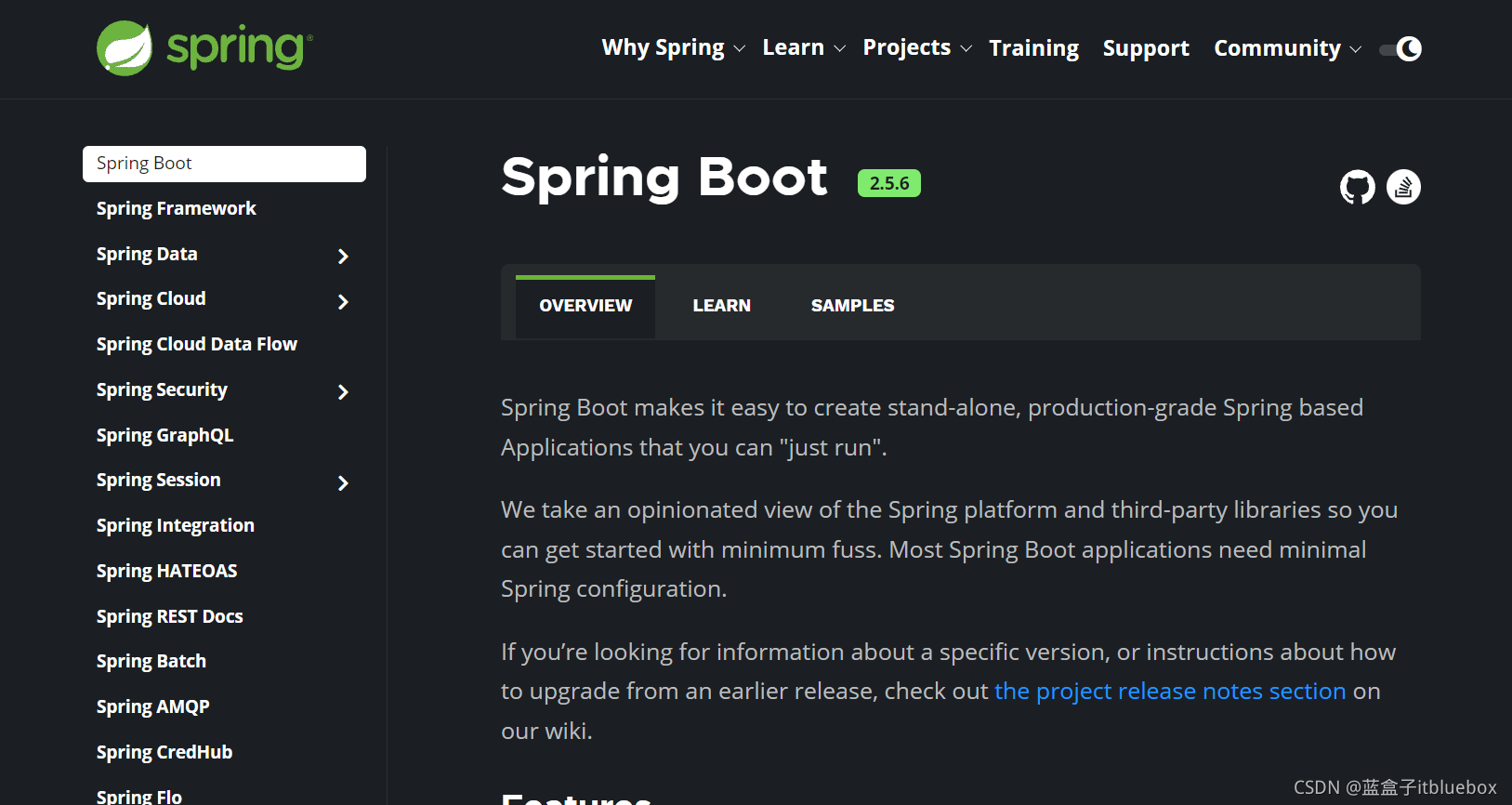
Spring 缺点
1) 配置繁琐
虽然Spring的组件代码是轻量级的,但它的配置却是重量级的。一开始,Spring用XML配置,而且是很多XML配置。
Spring 2.5引入了基于注解的组件扫描,这消除了大量针对应用程序自身组件的显式XML配置。
Spring 3.0引入了基于Java的配置,这是一种类型安全的可重构配置方式,可以代替XML。
所有这些配置都代表了开发时的损耗。因为在思考Spring特性配置和解决业务问题之间需要进行思维切换,所以编写配置挤占了编写应用程序逻辑的时间。和所有框架一样,Spring实用,但它要求的回报也不少。
2)依赖繁琐
项目的依赖管理也是一件耗时耗力的事情。
在环境搭建时,需要分析要导入哪些库的坐标,而且还需要分析导入与之有依赖关系的其他库的坐标,一旦选错了依赖的版本,随之而来的不兼容问题就会严重阻碍项目的开发进度。
二、SpringBoot 功能
1) 自动配置
Spring Boot的自动配置是一个运行时(更准确地说,是应用程序启动时)的过程,考虑了众多因素,才决定 Spring配置应该用哪个,不该用哪个。该过程是SpringBoot自动完成的。
2) 起步依赖
起步依赖本质上是一个Maven项目对象模型(Project Object Model,POM),定义了对其他库的传递依赖 ,这些东西加在一起即支持某项功能。
简单的说,起步依赖就是将具备某种功能的坐标打包到一起,并提供一些默认的功能。
3) 辅助功能
提供了一些大型项目中常见的非功能性特性,如嵌入式服务器、安全、指标,健康检测、外部配置等。
Spring Boot 并不是对 Spring 功能上的增强,而是提供了一种快速使用 Spring 的方式。
4)小结
SpringBoot提供了一种快速开发Spring项目的方式,而不是对Spring功能上的增强。
Spring的缺点:
? 配置繁琐
? 依赖繁琐
SpringBoot功能:
? 自动配置
? 起步依赖:依赖传递
? 辅助功能
三、SpringBoot 快速入门
1、案例:需求
搭建SpringBoot工程,定义HelloController.hello()方法,返回”Hello SpringBoot!”。
2、案例:实现步骤(搭建普通工程)
① 创建Maven项目
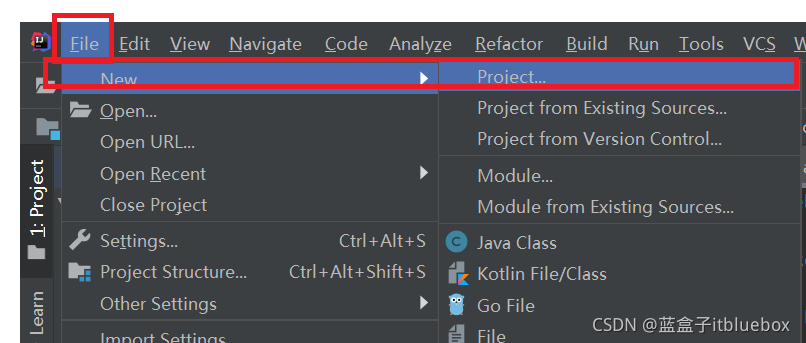


② 导入SpringBoot起步依赖

<?xml version="1.0" encoding="UTF-8"?>
<project xmlns="http://maven.apache.org/POM/4.0.0"
xmlns:xsi="http://www.w3.org/2001/XMLSchema-instance"
xsi:schemaLocation="http://maven.apache.org/POM/4.0.0 http://maven.apache.org/xsd/maven-4.0.0.xsd">
<modelVersion>4.0.0</modelVersion>
<groupId>cn.itbluebox</groupId>
<artifactId>springboot-helloworld</artifactId>
<version>1.0-SNAPSHOT</version>
<!--springboot工程需要继承的父工程-->
<parent>
<groupId>org.springframework.boot</groupId>
<artifactId>spring-boot-starter-parent</artifactId>
<version>2.5.6</version>
</parent>
<dependencies>
<!--web开发的起步依赖-->
<dependency>
<groupId>org.springframework.boot</groupId>
<artifactId>spring-boot-starter-web</artifactId>
</dependency>
</dependencies>
</project>
③ 定义Controller
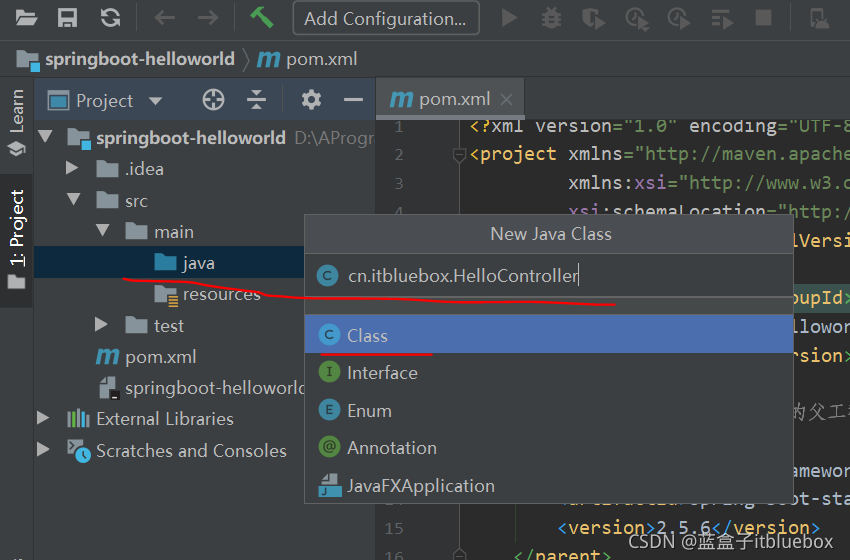

package cn.itbluebox;
import org.springframework.web.bind.annotation.RequestMapping;
import org.springframework.web.bind.annotation.RestController;
@RestController //设置当前类是一个Rest风格的Controller
public class HelloController {
@RequestMapping("/hello") //设置当前的方法的映射路径
public String hello(){
return "hello Spring Boot ! 我的第一个SpringBoot项目";
}
}
修改一下当前类所在的包

④ 编写引导类


package cn.itbluebox;
import org.springframework.boot.SpringApplication;
import org.springframework.boot.autoconfigure.SpringBootApplication;
/*
引导类SpringBoot项目的入口
*/
@SpringBootApplication
public class HelloApplication {
public static void main(String[] args) {
SpringApplication.run(HelloApplication.class,args);//args有没有都可以
}
}
⑤ 启动测试


访问
在日志信息当中可以看到对应的端口号

http://localhost:8080/hello

3、搭建工程(自动创建好对应的文件)





自动创建好所有的内容

四、SpringBoot 起步依赖原理分析
1、起步依赖原理分析
1) spring-boot-starter-parent
<!--springboot工程需要继承的父工程-->
<parent>
<groupId>org.springframework.boot</groupId>
<artifactId>spring-boot-starter-parent</artifactId>
<version>2.5.6</version>
</parent>
2) spring-boot-starter-web
<dependencies>
<!--web开发的起步依赖-->
<dependency>
<groupId>org.springframework.boot</groupId>
<artifactId>spring-boot-starter-web</artifactId>
</dependency>
</dependencies>
2、小结
? 在spring-boot-starter-parent中定义了各种技术的版本信息,组合了一套最优搭配的技术版本。
? 在各种starter中,定义了完成该功能需要的坐标合集,其中大部分版本信息来自于父工程。
? 我们的工程继承parent,引入starter后,通过依赖传递,就可以简单方便获得需要的jar包,并且不会存在版本冲突等问题
五、SpringBoot 配置
1、配置文件分类
(1)配置文件分类
SpringBoot是基于约定的,所以很多配置都有默认值,
但如果想使用自己的配置替换默认配置的话,就可以使用
application.properties或者application.yml(application.yaml)进行配置。
? properties:
server.port=8080
? yml:
server:
port: 8080
(2)设置对应端口号并创建其他的内容
1)设置端口号(application.properties)

server.port=8081
2)创建Controller


package cn.itbluebox.springbootinit.cn.itbluebox.controller;
import org.springframework.web.bind.annotation.RequestMapping;
import org.springframework.web.bind.annotation.RestController;
@RestController //设置当前类是一个Rest风格的Controller
public class HelloController {
@RequestMapping("/hello") //设置当前的方法的映射路径
public String hello(){
return "hello Spring Boot init ! 我的第二个SpringBoot项目";
}
}
3)运行并测试和启动,并访问

运行成功

http://localhost:8081/hello
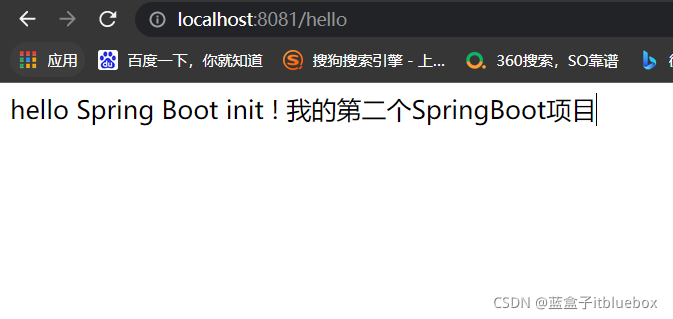
2、YAML
(1)YAML相关介绍
YAML全称是 YAML Ain’t Markup Language 。
YAML是一种直观的能够被电脑识别的的数据数据序列化格式,并且容易被人类阅读,容易和脚本语言交互的,可以被支持YAML库的不同的编程语言程序导入,比如: C/C++, Ruby, Python, Java, Perl, C#, PHP等。
YML文件是以数据为核心的,比传统的xml方式更加简洁。
YAML文件的扩展名可以使用.yml或者.yaml。
? properties:
server.port=8080
server.address=127.0.0.1
? xml:
<server>
<port>8080</port>
<address>127.0.0.1</address>
</server>
? yml:
server:
port: 8080
address: 127.0.0.1
简洁,以数据为核心
(2)YAML:基本语法
? 大小写敏感
? 数据值前边必须有空格,作为分隔符
? 使用缩进表示层级关系
? 缩进时不允许使用Tab键,只允许使用空格(各个系统 Tab对应的 空格数目可能不同,导致层次混乱)。
? 缩进的空格数目不重要,只要相同层级的元素左侧对齐即可
? # 表示注释,从这个字符一直到行尾,都会被解析器忽略。
server:
port: 8080
address: 127.0.0.1
name: abc
(3)YAML:数据格式
? 对象(map):键值对的集合。 注意冒号后的空格
person:
name: zhangsan
#行内写法
person: {name: zhangsan}
? 数组:一组按次序排列的值
address:
- beijing
- shanghai
#行内写法
address: [beijing,shanghai]
? 纯量:单个的、不可再分的值
msg1: 'hello \n world' # 单引忽略转义字符
msg2: "hello \n world" # 双引识别转义字符
? YAML:参数引用
name: lisi
person:
name: ${name} # 引用上边定义的name值
(4)YAML:使用方式
1)yml
创建application.yml


server:
port: 8082
- 将application.properties当中的内容注释掉

- 运行测试


http://localhost:8082/hello
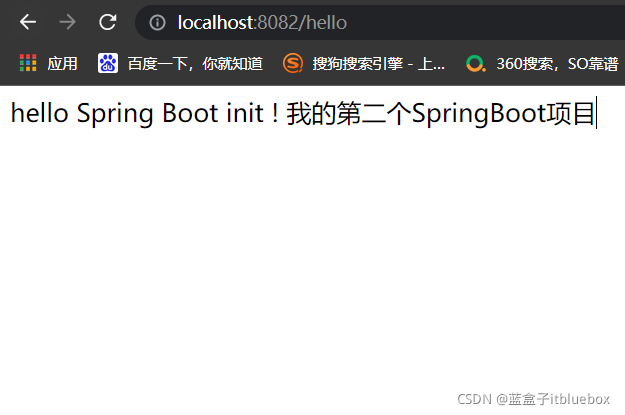
2)yaml
创建application.yaml


server:
port: 8083
将application.yml当中的内容注释掉

- 重新运行并测试


http://localhost:8083/hello

将三个配置文件当中的配置都打开



重新运行


上述证明application.properties的优先顺序高于application.yaml和application.yml
- 再测试application.yaml和application.yml,将application.properties当中的内容注释掉

运行测试


证明application.yml 要高于application.yaml优先级别
3、三种配置文件的优先加载顺序
优先级:application.properties高于application.yml 要高于application.yaml
六、读取配置文件当中的内容
1) @Value
1、在application.yml当中准备一些数据

server:
port: 8082
name: abc
# 对象
person:
name: 张三
age: 20
# 对象行内写法
person2: {name: 李四, age : 30}
# 数组
address:
- beijing
- shanghai
# 纯量
msg1: 'hello \n world' #不会识别转义字符,会原样输出
msg2: "hello \n world" #会识别转义字符,输出换行
2、HelloController当中通过@Value读取对应的值

package cn.itbluebox.springbootinit.cn.itbluebox.controller;
import org.springframework.beans.factory.annotation.Value;
import org.springframework.web.bind.annotation.RequestMapping;
import org.springframework.web.bind.annotation.RestController;
@RestController //设置当前类是一个Rest风格的Controller
public class HelloController {
@Value("${name}")//${}当中的内容必须和配置文件当中的键的值所对应
private String name;
@RequestMapping("/hello2") //设置当前的方法的映射路径
public String hello2(){
System.out.println(name);
return "hello Spring Boot init ! 我的第二个SpringBoot项目 name的值为:"+name;
}
@RequestMapping("/hello") //设置当前的方法的映射路径
public String hello(){
return "hello Spring Boot init ! 我的第二个SpringBoot项目";
}
}
运行测试

http://localhost:8082/hello2


3、获取对象的值

package cn.itbluebox.springbootinit.cn.itbluebox.controller;
import org.springframework.beans.factory.annotation.Value;
import org.springframework.web.bind.annotation.RequestMapping;
import org.springframework.web.bind.annotation.RestController;
@RestController //设置当前类是一个Rest风格的Controller
public class HelloController {
@Value("${name}")//${}当中的内容必须和配置文件当中的键的值所对应
private String name;
@Value("${person.name}")//${}当中的内容必须和配置文件当中的键的值所对应
private String name2;
@Value("${person.age}")//${}当中的内容必须和配置文件当中的键的值所对应
private int age;
@RequestMapping("/hello2") //设置当前的方法的映射路径
public String hello2(){
System.out.println(name);
System.out.println(name2);
System.out.println(age);
return "hello Spring Boot init ! 我的第二个SpringBoot项目 name的值为:"+name +" name2:"+name2+" age:"+age;
}
@RequestMapping("/hello") //设置当前的方法的映射路径
public String hello(){
return "hello Spring Boot init ! 我的第二个SpringBoot项目";
}
}
重新运行并测试


-参数注入
修改application.yml

server:
port: 8082
name: abc
# 对象
person:
name: ${name}
age: 20
# 对象行内写法
person2: {name: 李四, age : 30}
# 数组
address:
- beijing
- shanghai
# 纯量
msg1: 'hello \n world' #不会识别转义字符,会原样输出
msg2: "hello \n world" #会识别转义字符,输出换行
重新运行并测试

http://localhost:8082/hello2


4、获取数组的值

package cn.itbluebox.springbootinit.cn.itbluebox.controller;
import org.springframework.beans.factory.annotation.Value;
import org.springframework.web.bind.annotation.RequestMapping;
import org.springframework.web.bind.annotation.RestController;
@RestController //设置当前类是一个Rest风格的Controller
public class HelloController {
@Value("${name}")//${}当中的内容必须和配置文件当中的键的值所对应
private String name;
@Value("${person.name}")//${}当中的内容必须和配置文件当中的键的值所对应
private String name2;
@Value("${person.age}")//${}当中的内容必须和配置文件当中的键的值所对应
private int age;
@Value("${address[0]}")//${}当中的内容必须和配置文件当中的键的值所对应
private String address;
@RequestMapping("/hello2") //设置当前的方法的映射路径
public String hello2(){
System.out.println(name);
System.out.println(name2);
System.out.println(age);
System.out.println(address);
return "hello Spring Boot init ! 我的第二个SpringBoot项目 name的值为:"
+name +" name2:"+name2+" age:"+age
+" address:"+address
;
}
@RequestMapping("/hello") //设置当前的方法的映射路径
public String hello(){
return "hello Spring Boot init ! 我的第二个SpringBoot项目";
}
}
重新运行并测试
5、纯量的值

package cn.itbluebox.springbootinit.cn.itbluebox.controller;
import org.springframework.beans.factory.annotation.Value;
import org.springframework.web.bind.annotation.RequestMapping;
import org.springframework.web.bind.annotation.RestController;
@RestController //设置当前类是一个Rest风格的Controller
public class HelloController {
@Value("${name}")//${}当中的内容必须和配置文件当中的键的值所对应
private String name;
@Value("${person.name}")//${}当中的内容必须和配置文件当中的键的值所对应
private String name2;
@Value("${person.age}")//${}当中的内容必须和配置文件当中的键的值所对应
private int age;
@Value("${address[0]}")//${}当中的内容必须和配置文件当中的键的值所对应
private String address;
@Value("${msg1}")//${}当中的内容必须和配置文件当中的键的值所对应
private String msg1;
@Value("${msg2}")//${}当中的内容必须和配置文件当中的键的值所对应
private String msg2;
@RequestMapping("/hello2") //设置当前的方法的映射路径
public String hello2(){
System.out.println(name);
System.out.println(name2);
System.out.println(age);
System.out.println(address);
System.out.println(msg1);
System.out.println(msg2);
return "hello Spring Boot init ! 我的第二个SpringBoot项目 name的值为:"
+name +" name2:"+name2+" age:"+age
+" address:"+address
+" msg1:"+msg1
+" msg2:"+msg2;
}
@RequestMapping("/hello") //设置当前的方法的映射路径
public String hello(){
return "hello Spring Boot init ! 我的第二个SpringBoot项目";
}
}
重新运行并测试
2) Environment
获取对应的值


package cn.itbluebox.springbootinit.cn.itbluebox.controller;
import org.springframework.beans.factory.annotation.Autowired;
import org.springframework.beans.factory.annotation.Value;
import org.springframework.core.env.Environment;
import org.springframework.web.bind.annotation.RequestMapping;
import org.springframework.web.bind.annotation.RestController;
@RestController //设置当前类是一个Rest风格的Controller
public class HelloController {
@Value("${name}")//${}当中的内容必须和配置文件当中的键的值所对应
private String name;
@Value("${person.name}")//${}当中的内容必须和配置文件当中的键的值所对应
private String name2;
@Value("${person.age}")//${}当中的内容必须和配置文件当中的键的值所对应
private int age;
@Value("${address[0]}")//${}当中的内容必须和配置文件当中的键的值所对应
private String address;
@Value("${msg1}")//${}当中的内容必须和配置文件当中的键的值所对应
private String msg1;
@Value("${msg2}")//${}当中的内容必须和配置文件当中的键的值所对应
private String msg2;
@Autowired
private Environment env;//SpringBoot启动的时候会在Spring容器当中初始化Environment对象
@RequestMapping("/hello2") //设置当前的方法的映射路径
public String hello2(){
System.out.println(name);
System.out.println(name2);
System.out.println(age);
System.out.println(address);
System.out.println(msg1);
System.out.println(msg2);
System.out.println("-----------------");
System.out.println(env.getProperty("name"));
System.out.println(env.getProperty("person.name"));
System.out.println(env.getProperty("person.age"));
System.out.println(env.getProperty("address[0]"));
System.out.println(env.getProperty("msg1"));
System.out.println(env.getProperty("msg2"));
return "hello Spring Boot init ! 我的第二个SpringBoot项目 name的值为:"
+name +" name2:"+name2+" age:"+age
+" address:"+address
+" msg1:"+msg1
+" msg2:"+msg2
+" <br>env.getProperty(\"name)="+env.getProperty("name")
+" env.getProperty(\"person.name\")="+env.getProperty("person.name")
+" env.getProperty(\"person.age\")="+env.getProperty("person.age")
+" env.getProperty(\"address[0]\")="+env.getProperty("address[0]")
+" env.getProperty(\"msg1\")="+env.getProperty("msg1")
+" env.getProperty(\"msg2\")="+env.getProperty("msg2")
;
}
@RequestMapping("/hello") //设置当前的方法的映射路径
public String hello(){
return "hello Spring Boot init ! 我的第二个SpringBoot项目";
}
}
运行测试
重新运行并测试
3) @ConfigurationProperties
01)默认读取的注入
- 创建Person对象


package cn.itbluebox.springbootinit;
import org.springframework.boot.context.properties.ConfigurationProperties;
import org.springframework.stereotype.Component;
@Component //将Person 容器当中
@ConfigurationProperties
public class Person {
private String name;
private int age;
public Person() {
}
public Person(String name, int age) {
this.name = name;
this.age = age;
}
public String getName() {
return name;
}
public void setName(String name) {
this.name = name;
}
public int getAge() {
return age;
}
public void setAge(int age) {
this.age = age;
}
@Override
public String toString() {
return "Person{" +
"name='" + name + '\'' +
", age=" + age +
'}';
}
}
- 完善HelloController注入Person


package cn.itbluebox.springbootinit;
import org.springframework.beans.factory.annotation.Autowired;
import org.springframework.beans.factory.annotation.Value;
import org.springframework.core.env.Environment;
import org.springframework.web.bind.annotation.RequestMapping;
import org.springframework.web.bind.annotation.RestController;
@RestController //设置当前类是一个Rest风格的Controller
public class HelloController {
@Value("${name}")//${}当中的内容必须和配置文件当中的键的值所对应
private String name;
@Value("${person.name}")//${}当中的内容必须和配置文件当中的键的值所对应
private String name2;
@Value("${person.age}")//${}当中的内容必须和配置文件当中的键的值所对应
private int age;
@Value("${address[0]}")//${}当中的内容必须和配置文件当中的键的值所对应
private String address;
@Value("${msg1}")//${}当中的内容必须和配置文件当中的键的值所对应
private String msg1;
@Value("${msg2}")//${}当中的内容必须和配置文件当中的键的值所对应
private String msg2;
@Autowired
private Environment env;//SpringBoot启动的时候会在Spring容器当中初始化Environment对象
@Autowired
private Person person;
@RequestMapping("/hello2") //设置当前的方法的映射路径
public String hello2(){
System.out.println(name);
System.out.println(name2);
System.out.println(age);
System.out.println(address);
System.out.println(msg1);
System.out.println(msg2);
System.out.println("-----------------");
System.out.println(env.getProperty("name"));
System.out.println(env.getProperty("person.name"));
System.out.println(env.getProperty("person.age"));
System.out.println(env.getProperty("address[0]"));
System.out.println(env.getProperty("msg1"));
System.out.println(env.getProperty("msg2"));
System.out.println("------------------");
System.out.println("person"+person);
return "hello Spring Boot init ! 我的第二个SpringBoot项目 name的值为:"
+name +" name2:"+name2+" age:"+age
+" address:"+address
+" msg1:"+msg1
+" msg2:"+msg2
+" <br>env.getProperty(\"name)="+env.getProperty("name")
+" env.getProperty(\"person.name\")="+env.getProperty("person.name")
+" env.getProperty(\"person.age\")="+env.getProperty("person.age")
+" env.getProperty(\"address[0]\")="+env.getProperty("address[0]")
+" env.getProperty(\"msg1\")="+env.getProperty("msg1")
+" env.getProperty(\"msg2\")="+env.getProperty("msg2")
+" person = "+person
;
}
@RequestMapping("/hello") //设置当前的方法的映射路径
public String hello(){
return "hello Spring Boot init ! 我的第二个SpringBoot项目";
}
}
运行测试
重新运行并测试


@Component //将Person 容器当中
@ConfigurationProperties
public class Person {
上面默认读取的是

02)设置注入前缀

@ConfigurationProperties(prefix = "person")
运行测试
重新运行并测试

http://localhost:8082/hello2
得到Person对应的值


得到对应配置文件的值

03)设置对象当中有数组注入
- 修改application.yml

# 对象
person:
name: ${name}
age: 20
address:
- beijing
- shanghai
- 修改Person

package cn.itbluebox.springbootinit;
import org.springframework.boot.context.properties.ConfigurationProperties;
import org.springframework.stereotype.Component;
import java.util.Arrays;
@Component //将Person 容器当中
@ConfigurationProperties(prefix = "person")
public class Person {
private String name;
private int age;
private String[] address;
public Person() {
}
public Person(String name, int age, String[] address) {
this.name = name;
this.age = age;
this.address = address;
}
public String getName() {
return name;
}
public void setName(String name) {
this.name = name;
}
public int getAge() {
return age;
}
public void setAge(int age) {
this.age = age;
}
public String[] getAddress() {
return address;
}
public void setAddress(String[] address) {
this.address = address;
}
@Override
public String toString() {
return "Person{" +
"name='" + name + '\'' +
", age=" + age +
", address=" + Arrays.toString(address) +
'}';
}
}
运行测试
重新运行并测试


04)解决Person类上对应的红色警告(设置编写配置文件的时候自动提示)

点击后跳转到网页提示(添加如下的配置依赖)


<dependency>
<groupId>org.springframework.boot</groupId>
<artifactId>spring-boot-configuration-processor</artifactId>
<optional>true</optional>
</dependency>
点击

Person显示正常

同时在application.yml编写配置的时候会有一些提示信息
先删除其他的配置文件
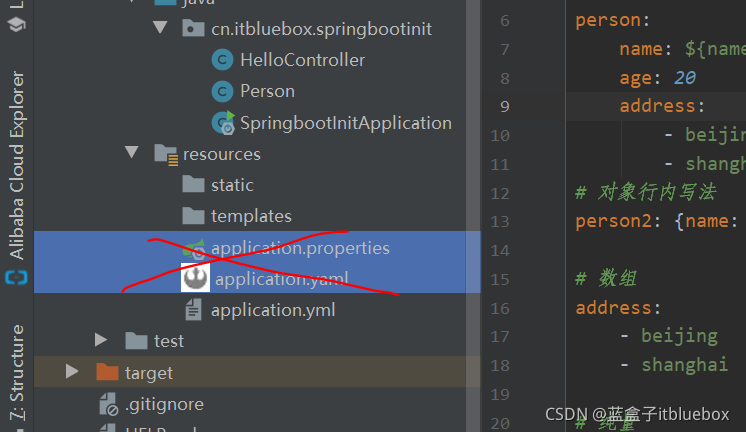
编辑application.yml的时候会有提示

七、profile和yml对应的配置
我们在开发Spring Boot应用时,通常同一套程序会被安装到不同环境,比如:开发、测试、生产等。其中数据库地址、服务器端口等等配置都不同,如果每次打包时,都要修改配置文件,那么非常麻烦。profile功能就是来进行动态配置切换的
1、创建新的模块





2、 profile配置方式
1)多profile文件方式
创建几个文件
- 创建application-dev.properties(开发环境的配置)


server.port=8081
- 创建application-test.properties(测试环境的配置)


server.port=8082
- 创建application-pro.properties(生产环境的配置)


server.port=8083
- 直接启动程序

默认端口号为8080,而且没有激活配置文件

2)profile激活方式
- 修改application.properties

spring.profiles.active的值需要和对应配置文件-后面从名称相符
spring.profiles.active=dev
上述配置激活了application-dev.properties
重新运行启动
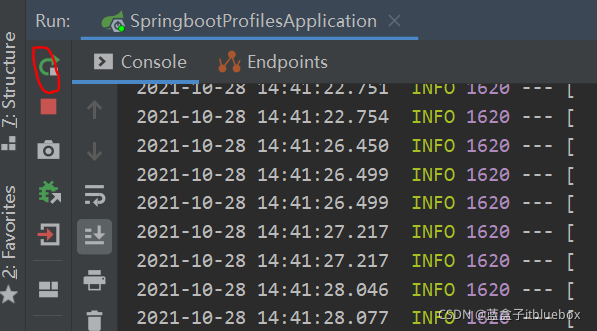
成功激活application-dev.properties配置文件对应的内容

-生产的时候激活pro

spring.profiles.active=pro

激活成功

3、yml多文档方式(配置和激活)
- 创建application.yml


---
server:
port: 8081
spring:
profiles: dev
---
server:
port: 8082
spring:
profiles: test
---
server:
port: 8083
spring:
profiles: pro
---
- 将properties相关内容都注释掉




直接重新运行

默认端口号为8080,没有激活配置文件

- 在application.yml当中设置对应的激活配置

---
server:
port: 8081
spring:
profiles: dev
---
server:
port: 8082
spring:
profiles: test
---
server:
port: 8083
spring:
profiles: pro
---
spring:
profiles:
active: pro


开启了8083端口,证明
---
server:
port: 8083
spring:
profiles: pro
---
配置生效,其他的配置也一样
4、虚拟机参数
- 也可以设置不修改配置文件



配置成功,虚拟机配置覆盖了配置文件的配置

5、命令行参数


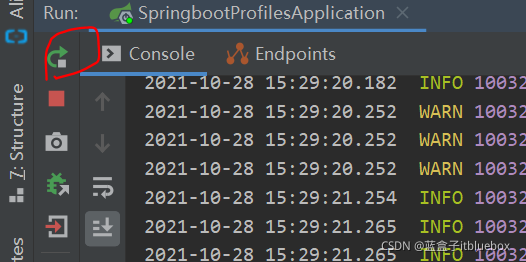
命令行参数配置成功

6、打包成jar运行的时候指定对应参数
(1)打包并运行

打包成功


在cmd当中进入对应的目录当中

java -jar springboot-profiles-0.0.1-SNAPSHOT.jar
运行成功使用的pro环境,端口号为8083

(2)指定参数运行(外部参数)
Ctrl+c停止运行

java -jar springboot-profiles-0.0.1-SNAPSHOT.jar --spring.profiles.active=dev
变成了dev环境,端口号为8081

八、内部配置的加载顺序
Springboot程序启动时,会从以下位置加载配置文件:
file:/config/:当前项目下的/config目录下file:./︰当前项目的根目录classpath:/config/: classpath的/config目录classpath:/: classpath的根目录
加载顺序为上文的排列顺序,高优先级配置的属性会生效
1、创建新的模块(测试 classpath:/ : classpath的根目录)





- 修改application.properties的配置文件

server.port=8081


2、创建config下对应的配置文件(classpath:/config/: classpath的/config目录)


将application.properties复制到config目录当中


server.port=8082

端口变为8082

九、外部配置的加载顺序
1、创建HelloController


package cn.itbluebox.springbootconfig;
import org.springframework.web.bind.annotation.RequestMapping;
import org.springframework.web.bind.annotation.RestController;
@RestController
public class HelloController {
@RequestMapping("/hello")
public String hello(){
return "你好";
}
}
2、打包当前项目

打包成功

打包后的路径,进入对应的目录打开cmd


java -jar springboot-config-0.0.1-SNAPSHOT.jar --server.port=8082 --server.servlet.context-path=/hehe

http://localhost:8082/hehe/hello

3、加载外部配置文件
在电脑随便的地方创建配置文件


java -jar springboot-config-0.0.1-SNAPSHOT.jar --spring.config.location=e://1/application.properties
端口号变为配置文件当中的8085

4、默认加载target目录下的配置文件
在target当中创建配置文件


java -jar springboot-config-0.0.1-SNAPSHOT.jar

http://localhost:8086/hello

在target下创建config目录,将配置文件创建到config目录下


java -jar springboot-config-0.0.1-SNAPSHOT.jar








